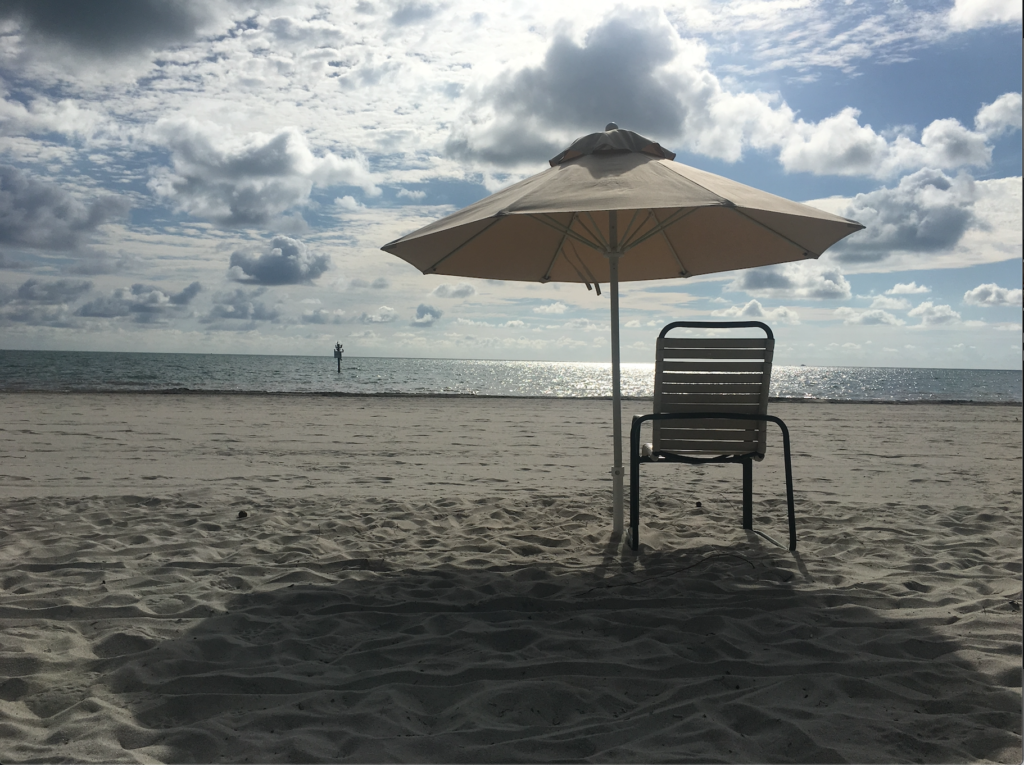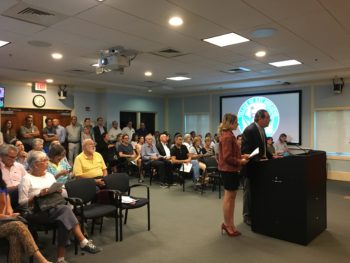The Murky Waters of the Beach Bacteria Problem
Annali HaywardOctober 21, 2019

Cloudy skies over an empty beach Tuesday as a no-contact water quality advisory was still in place. Key Biscayne residents are up in arms over water quality. A Nov. 5 workshop hopes to address it. (Key News_Annali Hayward)
Water quality issues reached fever pitch this week as residents, already accustomed to avoiding their beach, were barred entirely after an effluent overflow. Village Manager Andrea Agha released an email addressing the issues and outlining solutions, but questions persist.
Staff hope to provide some answers at a Nov. 5 public workshop, where a panel of at least 10 different stakeholders will discuss issues and field pre-vetted questions from residents.
The issue is complex, combining the agendas of Miami-Dade County bodies from the Water and Sewer Department to the Florida Department of Health and the Department of Environmental Resource Management. Resilience experts from the County and Miami Beach will also attend.
“I rarely say anything is above my paygrade,” said Miami-Dade County Commissioner Xavier Suarez, who is running for county mayor in 2020. “But the issue of water quality in Key Biscayne is intractable.”

County Commissioner Xavier Suarez addresses the regular Council meeting, Oct. 15. (Key News_Annali Hayward)
Suarez was invited to address the Council at the Oct. 15 meeting, a point which seemed to irk Agha, who asked in her letter to serve as “conduit” between the County and the Village in future.
Politics aside, Suarez later expanded on his views of the water quality issue. He said he is “unhappy” with his own department heads over the delay of a crucial “septic report” that will attempt to define whether the DNA of the bacteria is human or animal. Suarez’s resilience aide Yvonne Maffia said the report will arrive in two weeks.
Pipe dreams
If the report concludes human sources, pressure will mount on WASD to expedite improvements to sewage pipes, as well as on the Village to complete its ongoing project to convert the Key’s remaining septic tanks to the sewer system.
Agha’s letter largely focused on WASD’s efforts to investigate the pipes, particularly potential “exfiltration of sewer system waste to groundwater” – that is, sewage leaking into the water table and making its way to the sea, a process thought to be impacted by rainfall, tides and king tides.
WASD Director for Miami-Dade Douglas Yoder or his delegate will be at the workshop to explain his team’s projects. These include “systematic evaluation of pipelines and prioritizing replacement and repair work,” according to Yoder, who says his department has been working with the Village to evaluate conditions.
Director of Public Works and Building, Zoning and Planning Jake Ozyman says some of the Village’s old, vitrified clay pipes are “very possibly” leaking, having “outlived their life expectancy” since installation in the mid-1950s by the Key Biscayne Water Company. But this would not be the sole cause of raised bacterial levels, in his opinion.
Ozyman says he is talking to Yoder to ask them to accelerate televising, one of the measures in Agha’s letter, over the next couple of months. This process puts high-resolution cameras down pipes (at night, when there is less sewer activity) to look for leaks as small as one-tenth of a milimeter. Ozyman expects to find hairline fractures, and he said repairs on any major cracks could be “immediate.”
Agha also cited ‘smart’ manhole covers, devices that check whether pipes are either leaking sewage or taking on groundwater through cracks. WASD operates three permanent covers on Key Biscayne with an additional two over the past eight months, according to Yoder.
“We have not seen excessive flows over the past year at these locations,” he said, “which suggests that these lines are not leaking excessively.”
Yoder also said the department is “substantially reconstructing” all regional treatment plants. It was their Central plant on Virginia Key – currently under a consent decree for violating effluent limits –that spilled recently, though Yoder said only about 35,000 gallons of that reached the bay. He said tests on it showed “the effluent had about 6 colony-forming units (CFU) as compared with the 70 CFUs that results in an advisory.”
One of Ozyman’s main questions Nov. 5 will be on the department’s contingency plans for that plant, particularly in the event of a hurricane. “If a Hurricane Dorian hit us today, we’d be swimming in sewage. What are their plans?”
A 2008 Florida law mandated all ocean outfall pipes, like the one at Virginia Key, to be replaced by deep-injection wells by 2025. But the status of that project is unclear, with no update on the website since 2017. “Some say it is way off schedule,” said Ozyman.
Calling time on tanks
As for the septic tanks, there are 154 left on the Key, and Ozyman says DERM is behind in enforcement. Six houses in the Holiday Colony area missed their Oct. 9 hook-up deadline. The next zone facing a deadline is on the western side of the Key around West McIntyre Street, where 25 houses must connect by Dec. 29. The final two zones, with a June 2020 deadline, cover 123 houses. However, according to Village Resilience Coordinator Katarzyna Kulpa, when DERM delineated the zones’ boundaries, seven properties were left “outside the project.”
“DERM is in the process of sending Notice of Required Connection [letters],” said Kulpa.
The properties will then have 90 days to connect. “If not, they will get additional notices and eventually a violation notice with the fee,” Kulpa said.
Ozyman prefers to gain compliance. He says Village Chief Plumbing Inspector John Lindgren, who will inspect each connection, will go door-to-door to talk to residents in the coming weeks.
Septic tanks can work well in higher elevations, but Key Biscayne’s probably sit on or just above the groundwater, according to Ozyman. He hopes the project will be finished by July – but he has a bigger question for the County Nov. 5.
“There are thousands of septic tanks all over Miami. What about those?”
Another measure Ozyman is planning may help ascertain any link between septic tanks and E. coli as well as enterococci. During the Oct. 27 king tides, his team will test 16 locations to see if the water that sits on the street during these events contains harmful bacteria. Previous salinity tests show low salt content, suggesting floodwater is mostly rain and groundwater welling up, as opposed to backflow from the outfall pipes that take excess water off the Key in 17 locations. This is likely due to valves that ensure water can escape but seawater cannot come back in.
Examining enterococci
If Suarez’s septic report shows animal sources, attention will likely focus on runoff – that is, water that builds up on land during heavy rain or flooding, which flows back into the ocean, bringing with it animal feces as well as fertilizers – nutrients from which could be spurring bacteria growth.
Council Member Katie Petros is due to propose a fertilizer ordinance in one of the next few Council meetings, based partly on regulations adopted in Surfside this summer.
Compounding the issue, the Village continues to employ contractors Beach Raker, who will be on the Nov. 5 panel, to bury sargassum that washes up into the sand. This process is suspected to harbor bacterial growth, a suggestion previously made by nonprofit Miami Waterkeeper, another panelist.
In February the Council approved $50,000 for a yearlong University of Miami study into bacteria sources. Preliminary results are not available but reports indicate they are likely to show a link between the presence of sargassum and higher levels of enterococci in the sand just above the shoreline. Bacteria is released from this zone during king tides.
As previously reported, study leader Professor Helena Solo-Gabriele has stated “it is unlikely that the [bacteria] source is the wastewater treatment plant.”
Dr. Salmir Elmir of the FDOH will also be present Nov.5. He says all doctors are “required by state law to report swimming-related illnesses to the DOH,” but that he is “not aware of any recent or past reports.” Illnesses could range from gastroenteritis to respiratory diseases and ear, eye or skin ailments.
Solve for X
Lessons are already being learned. “From the beginning all departments should have got together with the Village of Key Biscayne and walked the entire span of that beach,” said Suarez, who reiterated there are both short– and long-term solutions, including pressuring the U.S. Army Corps of Engineers to include Key Biscayne in its beach renourishment plans.
Whether he will lead them is the question.
“Yvonne and I get kicked out of this office in 10 months and we’ll be taking all this knowledge with us,” said Suarez, with a look ahead to his mayoral campaign. “So I hope people will vote for me.”


